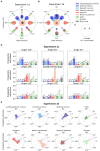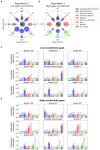Gaze direction as a facial cue of memory retrieval state
- PMID: 36619020
- PMCID: PMC9813397
- DOI: 10.3389/fpsyg.2022.1063228
Gaze direction as a facial cue of memory retrieval state
Abstract
Gaze direction is a powerful social cue that indicates the direction of attention and can be used to decode others' mental states. When an individual looks at an external object, inferring where their attention is focused from their gaze direction is easy. But when people are immersed in memories, their attention is oriented towards their inner world. Is there any specific gaze direction in this situation, and if so, which one? While trying to remember, a common behavior is gaze aversion, which has mostly been reported as an upward-directed gaze. Our primary aim was to evaluate whether gaze direction plays a role in the inference of the orientation of attention-i.e., external vs. internal-in particular, whether an upward direction is considered as an indicator of attention towards the internal world. Our secondary objective was to explore whether different gaze directions are consistently attributed to different types of internal mental states and, more specifically, memory states (autobiographical or semantic memory retrieval, or working memory). Gaze aversion is assumed to play a role in perceptual decoupling, which is supposed to support internal attention. We therefore also tested whether internal attention was associated with high gaze eccentricity because the mismatch between head and eye direction alters visual acuity. We conducted two large-sample (160-163 participants) online experiments. Participants were asked to choose which mental state-among different internal and external attentional states-they would attribute to faces with gazes oriented in different directions. Participants significantly associated internal attention with an upward-averted gaze across experiments, while external attention was mostly associated with a gaze remaining on the horizontal axis. This shows that gaze direction is robustly used by observers to infer others' mental states. Unexpectedly, internal attentional states were not more associated with gaze eccentricity at high (30°) than low (10°) eccentricity and we found that autobiographical memory retrieval, but not the other memory states, was highly associated with 10° downward gaze. This reveals the possible existence of different types of gaze aversion for different types of memories and opens new perspectives.
Keywords: autobiographical memory retrieval; eye movements; facial cues; gaze aversion; internal attention; social cues.
Copyright © 2022 Servais, Hurter and Barbeau.
Conflict of interest statement
The authors declare that the research was conducted in the absence of any commercial or financial relationships that could be construed as a potential conflict of interest.
Figures




Similar articles
-
Attentional switch to memory: An early and critical phase of the cognitive cascade allowing autobiographical memory retrieval.Psychon Bull Rev. 2023 Oct;30(5):1707-1721. doi: 10.3758/s13423-023-02270-w. Epub 2023 Apr 28. Psychon Bull Rev. 2023. PMID: 37118526 Review.
-
Why and when do you look away when trying to remember? Gaze aversion as a marker of the attentional switch to the internal world during memory retrieval.Acta Psychol (Amst). 2023 Oct;240:104041. doi: 10.1016/j.actpsy.2023.104041. Epub 2023 Sep 27. Acta Psychol (Amst). 2023. PMID: 37774488
-
Influences of eye gaze cues on memory and its mechanisms: The function and evolution of social attention.Front Psychol. 2022 Oct 14;13:1036530. doi: 10.3389/fpsyg.2022.1036530. eCollection 2022. Front Psychol. 2022. PMID: 36312084 Free PMC article. Review.
-
Effects of Peripheral Eccentricity and Head Orientation on Gaze Discrimination.Vis cogn. 2014 Jan 1;22(9-10):1216-1232. doi: 10.1080/13506285.2014.990545. Vis cogn. 2014. PMID: 28344501 Free PMC article.
-
Social communication with virtual agents: The effects of body and gaze direction on attention and emotional responding in human observers.Int J Psychophysiol. 2015 Aug;97(2):85-92. doi: 10.1016/j.ijpsycho.2015.05.007. Epub 2015 May 21. Int J Psychophysiol. 2015. PMID: 26004021
Cited by
-
An action-observation method for studying social perception: a mini-review.Front Psychol. 2024 Sep 25;15:1473498. doi: 10.3389/fpsyg.2024.1473498. eCollection 2024. Front Psychol. 2024. PMID: 39386134 Free PMC article. Review.
-
A systematic review of eye movements during autobiographical recall: Does the mind's eye look at pictures of personal memories?Psychon Bull Rev. 2025 Aug;32(4):1487-1503. doi: 10.3758/s13423-025-02641-5. Epub 2025 Feb 4. Psychon Bull Rev. 2025. PMID: 39904842 Review.
-
Attentional switch to memory: An early and critical phase of the cognitive cascade allowing autobiographical memory retrieval.Psychon Bull Rev. 2023 Oct;30(5):1707-1721. doi: 10.3758/s13423-023-02270-w. Epub 2023 Apr 28. Psychon Bull Rev. 2023. PMID: 37118526 Review.
References
-
- Admoni H., Scassellati B. (2017). Social eye gaze in human-robot interaction: a review. J. Human-Robot Interact. 6:25. doi: 10.5898/jhri.6.1.admoni - DOI
-
- Andrist S., Tan X. Z., Gleicher M., Mutlu B. (2014). Conversational gaze aversion for humanlike robots. ACM/IEEE Int. Conf. Human-Robot Interact. 2014, 25–32. doi: 10.1145/2559636.2559666 - DOI
-
- Baron-cohen S., Cross P. (1992). Reading the eyes: evidence for the role of perception in the development of a theory of mind. Mind Lang. 7, 172–186. doi: 10.1111/j.1468-0017.1992.tb00203.x - DOI
LinkOut - more resources
Full Text Sources

